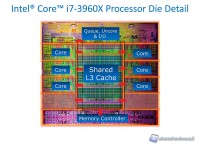Sandy Bridge-E: A die with record size
20.8 * 20.9mm, an area of 434.72 mm2 which contains 2.2 billion transistors. These are the numbers of Sandy Bridge-E. In fact it is the biggest die ever for a desktop CPU. For comparison Sandy Bridge LGA 1155 has an area of 216mm2 (complete of integrated graphics) and hexa-core Gulftown CPUs (i7 990X) an area of 239mm2. What Intel has done with well 200mm2 more than previous hexa-core generation? From specification we note 3MB more of L3 cache and a wider I/O section: 4-channel memory controller instead of 3 and as many as 40 PCI Express lanes managed on the X58 LGA 1366 platforms. This is not enough to justify a die almost double in size.
The image of the die provided by Intel is quite enlightening. These CPUs have 8 cores (including its L2 cache), of which two are disabled. Considering the image of a 2700K die, Sandy Bridge-E seems got from the displacement of two Sandy Bridge CPU, where the graphic has been replaced by the larger memory controller. The modularity of this solution is guaranteed by the token ring bus for access to the shared L3 cache, introduced about a year ago and in which they were already highlighted the clear benefits for CPUs with more cores.
We tried to outline in an image a hypothetical ring-bus operation in Sandy Bridge-E albeit with some uncertainty as to the direct access to the cache by the Uncore and memory. This is in fact managed by Sandy Bridge System Agent, who died in the LGA 2011 platform.
But let's try to shed light on the reason for the deactivation of the two cores. The first reason is certainly the TDP, 32nm process is really to the limit in order to ensure a TDP of 130W at a 8-core CPU. This is possible, limiting the frequency and operating voltage, but at the expense of performance in single-threaded applications. Given still the lack of optimization of a lot of software and even some games, it would be a counterproductive move to the main targets of these CPUs, the enthusiast users and the more demanding gamers. Another reason for the deactivation of two cores (and maybe even 1MB of L3 cache, 16MB compared to the theoretical two side by side Sandy Bridge) is certainly due to the problem of yield production of a chip that big. In a 435mm2 chip is easy to detect errors or manufacturing problems of any transistors that could jeopardize the entire operation of the CPU. Intel recovers not working CPUs in this way by turning off those core with manufacturing problems. Similarly they may select the most overclockable core, providing users with high-quality CPU.
The 8-core versions may instead be used in servers, where multithreading is better utilized to possibly lower operating frequencies. Images of some LGA 2011 8-core Xeon have already appeared on the Internet.
Finally, as we shall see, even with only 6-core the Sandy Bridge-E CPUs still provide high-level performance, improving substantially performance compared to Sandy Bridge in multi-threaded applications. The gap with Gulftown is instead evident in all applications. On the other hand, competition seems far from the performance of Intel's top of the range, so there is not great competition in this market segment such that they should push for further improvements of the "flagship" solutions.
The LGA 2011 platform offers significant improvement over the LGA 1366, we will analyze in the next section.



